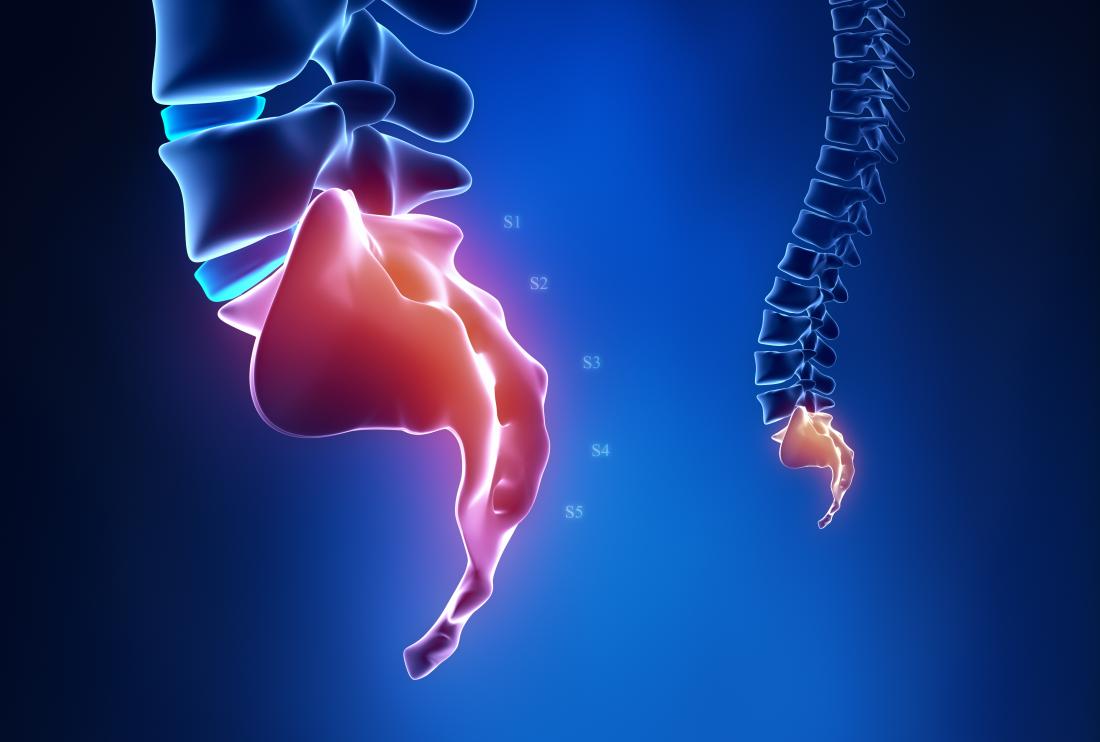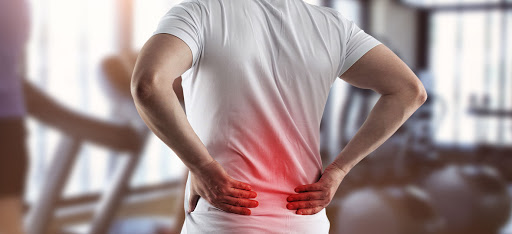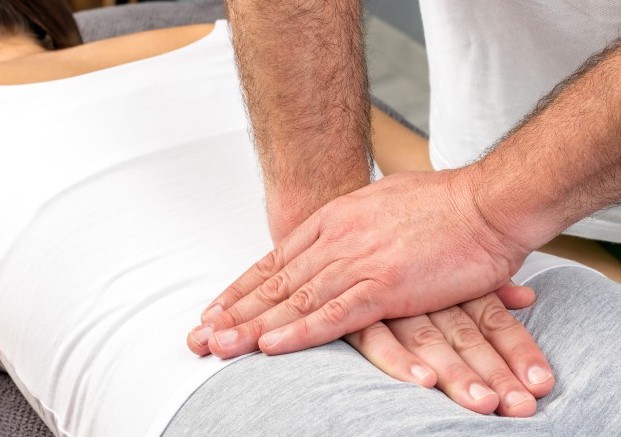Tailbone pain also referred to as coccydynia can be a dull ache or a sharp pain in and around the small triangular bone at the bottom of your spinal column. The pain could be sharp or stabbing and may radiate from the coccyx to the hips, thighs, or the rectum which can make sitting difficult, exercise painful, and disrupt sleep.
The pain can occur due to degenerative joint changes as well as due to acute or repetitive trauma. Common causes of coccydynia can occur due to horseback riding and vaginal delivery. The pain and discomfort might occur while sitting, standing for a long time, getting up from seated position, during bowel movements and while sex is also quite common.

CAUSES OF TAILBONE PAIN
Various muscles, tendons,and ligaments attach at the tailbone. Tailbone consists of three to five fused small vertebrae (bones) known as coccygeal vertebral bones. The bones are connected together with several tendons, muscles and ligaments. These are
located at the end of the spinal column, below the sacrum, that is a triangle-shaped bone located between two hip bones (ischial tuberosities). Both coccyx and ischial tuberosities bear the body’s weight while we are in seated position.
Tailbone pain can be caused due to 3 types of event:
- External Trauma: An external trauma caused by bruising, dislocation, or a broken coccyx resulting from a fall usually in a seated position. This can also be a result of repetitive strain caused to muscles, ligaments, and spine, which leads to pain during activities like cycling or rowing.
- Internal Trauma: Internally the trauma caused by a vaginal childbirth, sitting on a narrow and hard surface for a long period of time, driving or sitting on a cushioned surface in an awkward position. Childbirth causes the ligaments and muscles around the coccyx to get stretched and strained causing the pain. Rarely, during childbirth the bones of the coccyx break.
- Others: Infection like pilonidal cysts infection or Osteomyelitis, abscess like hemorrhoids and tumors like chordoma (could be cancerous), prostate cancer, colorectal cancer or vertebral tumor. Sometimes the cause for tailbone pain is not known. It rarely can be caused due to coccyx injuries like bone spurs, compression of nerve roots like over activity or irritation of ganglion impar (bundle of nerve above coccyx) or injuries to other parts of your spine. Tailbone pain could also be caused due to levator syndrome that is a condition causing spasms in the muscles of the anus which may radiate the pain to tailbone, hips, or other nearby areas.

SYMPTOMS OF TAILBONE PAIN
The symptoms of the tailbone pain are described as:
- Piercing or sharp pain in the tailbone.
- Tenderness in the tailbone area
- Visible bruise due to external trauma
- The pain worsens while changing from sitting to standing up.
- The pain aggravates when sitting for long duration
- Bowel movements and straining are painful
- Pain during sex especially in female with tailbone pain
- Depression, anxiety or loss of sleep due to above symptoms
- Pain in the buttocks.
- Pain in back
DIAGNOSIS OF TAILBONE PAIN
The doctor would initially do a physical examination to find out any signs of trauma like bruising, swelling, rash, or infection (warmth, redness, or any discharge). The doctor would press the area to check for localized tenderness indicating fracture. He or she would also check for skin dimples that indicate coccyx bone spur.
The healthcare provider would recommend various tests like X-ray to check for tailbone injury as well as any alignment problems, dislocations, or fractures of the tailbone and MRI to detect any cancer or infection of the coccyx.

TREATMENT OF TAILBONE PAIN
The Treatment regime for coccydynia is usually noninvasive which includes activity modification. About 90% of the cases respond well to non-surgical treatments. The condition would improve over a few weeks or months.
- Self Care – Simple treatments would be more effective in treatment like:
- Coccyx Cushion – Using specially designed coccyx cushion helps in reducing the pressure on your tailbone while in seated position.
- Avoid sitting for prolonged time – Prolonged sitting would put pressure on the tailbone causing the pain. Try to stand up and walk around after some time. Leaning forward while seated would also reduce the pain.
- Follow RICE (Rest, ice, compression and elevation) method – Adequate rest along with application of hot or cold packs would help the inflammation and pain. Compression and elevation of the area would also reduce the swelling and decrease the degree of pain.
- Using Laxatives – Bowel movements are painful in case of tailbone pain. Laxatives help the bowel movement smooth and do not aggravate the pain. Increasing the fiber and water intake would also avoid constipation which increases the tailbone pain during bowel movement.
- Painkillers – Along with self care over-the-counter or other painkillers can be taken to reduce the pain and discomfort.
- Anti-inflammatory painkillers (NSAIDs) – non-steroidal anti-inflammatory drug (NSAID) like ibuprofen (Advil), naproxen (Aleve) or COX-2 inhibitors (Celebrex) help in reducing the inflammation and easing the pain around coccyx. They are helpful in mild to moderate pain.
- Stronger painkillers – If the pain is severe NSAID would not be helpful. Thus the doctor might prescribe stronger painkillers like tramadol or opioids for a short duration of time as they are additive and have side-effects like constipation, headaches and dizziness. The dosage of these medicines is reduced gradually to avoid any withdrawal symptoms.
- Physiotherapy – The pain could be reduced or alleviated by massaging the tense pelvic floor muscles that are attached to the coccyx. Muscle tension in this region can cause added pressure on the ligaments and sacrococcygeal joint. This would increase the mobility or pulling on the coccyx. Stretching the ligaments attached to the coccyx gently would be helpful in reducing muscle tension around the coccygeal area. A physiotherapist or chiropractor would guide about the appropriate stretches for relieving coccyx pain.
- Manual Manipulation – The doctor would adjust the joint between the sacrum and the coccyx. This would potentially reduce pain caused due to inadequate coccyx mobility.
- Injection – In case the pain is severe and does not subside with a strong painkiller, the doctor would prescribe an injection of numbing agent like lidocaine and steroid. This would decrease the inflammation and ease the pain in the area surrounding the coccyx. Doctors would use the guidance with imaging techniques to ensure that the injection is administered to the affected area. Doctors might also recommend injecting local anesthetic into the nerves that supply the coccyx known as nerve block to help reduce the pain signals coming from them.
- Surgery – If the non-surgical treatment regime does not provide relief the doctor would opt for surgical removal of all or a portion of the coccyx referred to as coccygectomy. The surgery is not complex however; the recovery takes a long duration. This would provide relief from pain and other symptoms.
OUTLOOK
Many tailbone injuries cannot be prevented. However, it is important to use the appropriate protective equipment for sports. The right padding would reduce the risk of injuries to the tailbone. Sometimes the tailbone pain does not require any treatment but consulting the doctor would avoid any major complication.
If you or anyone you know is suffering from tailbone pain, our expert providers at Specialty Care Clinics will take care of your health and help you recover.
Call us on 469-545-9983 to book an appointment with Dr. Raymond Fulp.
